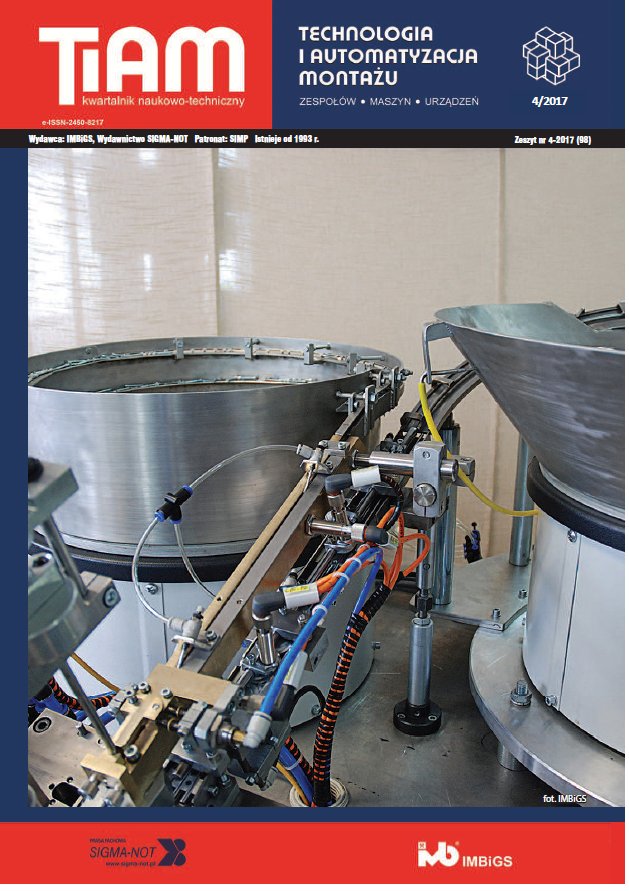Abstract
The paper presents the results of experimental studies determining the strength of adhesive joint between fiberglass composite and aluminium alloy 2024-T3 sheet. The specimens were made using autoclave technology. This article consider the important issue of the static strength of the inter-layer joint subjected to the normal direction, which causes a peel stress in the model used. The adhesive bond between the materials was made using an adhesive film with a mesh to ensure a uniform distribution of adhesive thickness. After the strength tests, the surfaces of adherends were analyzed on the basis of images made using SEM microscopy. A three-dimensional surface structure analysis was also performed. Studies have shown the high quality of the adhesive joint obtained and may be a reference to specimens made using other technologies.
This is an Open Access article distributed under the terms of the Creative Commons Attribution License CC BY 4.0 (https://creativecommons.org/licenses/by/4.0/)
References
Adams R. D., V. Mallick. 1993. “The effect of temperature on the strength of adhesively-bonded composite- aluminium joints”. International Journal of Adhesion and Adhesives (43):
Da Silva L. F., R. D. Adams. 2006. “Stress-free temperature in a mixed-adhesive joint”. Journal of Adhesion Science and Technology (20): 1705–1726.
Da Silva L. F., R. D. Adams. 2007. “Techniques to reduce the peel stresses in adhesive joints with composites”. International Journal of Adhesion and Adhesives (27): 216–226.
Giannis S., K. Hansen. 2010. “Investigation on the Joining of CFRP-to-CFRP and CFRP-to-Aluminium for a Small Aircraft Structural Application”. Dayton: 25th Technical Conference of the American Society for Composites and 14th US-Japan Conference on Composite Materials.
Hua Y., L. G., M. Trogdon M. 2012. “Three-dimensional modeling of carbon/epoxy to titanium single-lap joints with variable adhesive recess length”. International Journal of Adhesion and Adhesives (38): 25–30.
Ishii K., M. Imanaka, H. J. Nakayama. 2007. “Fatigue crack propagation behavior of adhesively-bonded CFRP/aluminum joints”. Journal of Adhesion Science and Technology (21): 153–167.
Kang S., M. Kim, C. Kim. 2007. “Evaluation of cryogenic performance of adhesives using composite aluminum double-lap joints”. Composite Structures (78): 440–446.
Khoshravan M., F. A. Mehrabadi. 2012. “Fracture analysis in adhesive compositematerial/aluminum joints under mode-I loading, experimental and numerical approaches”. International Journal of Adhesion and Adhesives (39): 8–14.
Narasimhan S., R. A. Shenoi, H. K. Jeong. 2004. “Three-dimensional stresses in adhesively bonded lap joints with non-identical adherends”. Proceedings of the Institution of Mechanical Engineers, Part L (218): 283–298.
Norma PN EN-ISO 25178-2:2012E Specyfikacja geometrii wyrobów: Przestrzenna – Część 2: Terminy, definicje i parametry struktury geometrycznej powierzchni.
Owens J., P. Lee-Sullivan. 2000. “Stiffness behavior due to fracture in adhesively bonded composite- to-aluminum joints II”. In International Journal of Adhesion and Adhesives (20): 47–58.
Seong M. et. al. 2008. “A parametric study on the failure of bonded singlelap joints of carbon composite and aluminum”. Composite Structures (86): 135–145.
Teixeira de Freitas S., J. Sinke. 2014. “Adhesion Properties of Bonded Composite-to-Aluminium Joints Using Peel Tests”. International Journal of Adhesion and Adhesives (90): 511–525.


